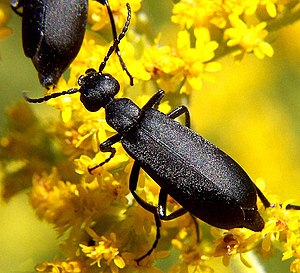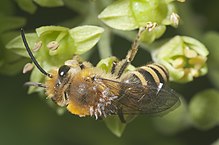Oil beetle
| Oil beetle | ||||||||||||
|---|---|---|---|---|---|---|---|---|---|---|---|---|

|
||||||||||||
| Systematics | ||||||||||||
|
||||||||||||
| Scientific name | ||||||||||||
| Meloidae | ||||||||||||
| Gyllenhaal , 1810 |
The oil beetles (Meloidae), also known as bladder beetles and plaster beetles as well as "May worms" , are a family of beetles (Coleoptera) with around 2500 species worldwide . In Europe they occur with 210 species and subspecies, of which 37 species also live in Central Europe .
features
The beetles reach a body length of 5 to 45 millimeters, but most of them reach around 10 millimeters. The body shape of the animals is very different; for there are both elongated and squat types. The head of the animals is large, severely constricted and inclined downwards. The conspicuous Meloë species in particular have shortened wing-coverts and have completely reduced the hind wings, so they are not able to fly. Other species, however, have fully functional wings, including the famous Spanish fly ( Lytta vesicatoria ). In the species that feed on nectar , parts of the maxilla are greatly elongated, but not transformed into a proboscis . This is especially the case with the genera Leptopalpus and Nemognatha . Their legs have five tarsal links in the front and in the middle , and four in the back. Their antennae are thread-shaped and have seven to eleven links, which can be elongated to spherical in their design. The males of the genus Cerocoma have completely irregularly shaped antennae.
Occurrence
They live mainly in warm areas. In Europe, for example, they are found in dry forests and on slopes and steppe meadows.
Way of life
The adults can be found on flowers, leaves or on the ground. They produce toxic antibodies that are contained in their blood, the hemolymph . In the event of danger, they can let the liquid escape from pores on their leg joints ( reflex bleeding ). This is very reminiscent of oil droplets and gave the beetles their name. The main active ingredient is cantharidin and primarily protects against ants and ground beetles . Other animals such as B. the hedgehog, but also many birds, are immune to this poison, which limits the protective effect. The cantharidin is absorbed and stored by several insects that are attracted by the substance over great distances. These include midges (Ceratopogonidae), flower flies (Anthomyiidae), soft bugs (Miridae), reticulated bugs (Tingidae), brackish wasps (Braconidae), flower mole beetles ( Anthicidae), fire beetles (Pyrochroidae), some roth beetles (Staphylinidae) and leaf beetles ( Staphylinidae ). In unicorn beetles ( Notoxus ), for example, the females check the cantharidin content by biting the elytric gland during mating. The cantharidin is passed into the spermatheca and protects the eggs, larvae and pupae from predators.
nutrition
As an imago, most species of oil beetles are herbivores that feed on leaves. Some species can also cause economic damage if they occur in large numbers , such as Epicauta rufidorsum on clover , potatoes and sugar beets .
Reproduction and development


C - 3rd larval stage, D - dummy pupa ,
E - pupa , F - imago
The larvae of the oil beetle live exclusively parasitically , especially in the nests of solitary bees (for example sand bees or fur bees ), or in clusters of locusts . The females lay about 2000 to 10,000 eggs because the loss rates are very high. The larvae develop via hypermetamorphosis , so the various larval stages are designed differently. The first stage is designed as a three-clawed ( triungulinus ) and serves as a spreading stage by clinging to a potential host animal. In the triungulinus there are three claw-like structures on the last phalanx: a claw and two claw-like bristles. In the triungulinus state, the larva can go without food for several weeks.
Phoresia takes place in nests of aculeater hymenoptera in Meloe and Sitaris , active search for nests of earth bees in Lytta and egg clutches of jumping insects in Mylabris and Epicauta .
The larvae of Meloë violaceus, for example, wait for flowers and cling to approaching insects. Larvae of other oil beetles use different methods to get into a bee nest. Pressed together, they simulate a female bee ( mimetic ). As soon as a male bee wants to mate the supposed female, the larvae attach to his belly. If the bee mates with a real female later, the larvae migrate over to her body and let the bee take them to her nest ("phoresia").
Once there, the Triungulinus - L1 ( campodeid , i.e. with strong legs) eats the bee egg and sheds its skin to the secondary larva - L2 ( caraboid ), which consumes the honey supply. Additional moults can now follow, i. d. R. another caraboid - L3 and then two scaraboid - L4 and L5. Then the larva leaves the bee cell and sheds its skin in the ground to form a legless, overwintering dummy pupa ( pseudonymphe or larva coarctata pharata ) - L6. Persisting in this, the animal sheds its skin in late spring to form the tertiary larva - L7, which is similar to the secondary larva, but does not eat any food. Pupation takes place four to five weeks later.
Because of the similarity of the triungulus larva with the larvae of the fan-winged , whose systematic position is a mystery, these were occasionally seen as a split from the relationship of the oil beetle and grouped into the order of the beetles. The likewise parasitic way of life of the great fan wing seemed to underpin this theory and also to provide the explanation for the strongly modified body structure. In the meantime, this theory is no longer tenable because of too many, including fundamental, differences.
Sequestration
Oil beetles are eaten by some animals in order to enrich their toxins , for example the spur goose .
use
In humans, the cantharidin under the name "Spanish fly" (obtained from the Spanish fly ) had market significance as an aphrodisiac . In ancient Greece it was also administered against intestinal diseases. But even small doses can be toxic to humans, and higher doses can even be fatal. It is used particularly in the context of homeopathy and animal homeopathy under the name “Cantharis vesicatoria”, with a similar indication to the homeopathic “Apis mellifica”. In some countries, u. a. in the United States, this use is prohibited.
Systematics



The types of oil beetles are divided into four subfamilies with further subgroups:
-
Eleticinae
- Derideini
- Eleticini
- Morphozonitini
- Spasticini
-
Meloinae
- Cerocomini
- Epicautini
- Epicauta pennsylvanica
- Epicauta rufidorsum
- Eupomphini
- Lyttini,
- Spanish fly ( Lytta vesicatoria )
- Berber omeloe majalis
- Physomeloe corallifer
- Meloini
- Black- and- blue oil beetle or black mayworm ( Meloë proscarabaeus )
- Violet oil beetle or violet mayworm ( Meloë violaceus )
- Gloss black oil beetle ( Meloë coriarius )
- Meloë franciscanus
- Mylabrini
- Four-point oil beetle ( Mylabris quadripunctata )
- Pannonian oil beetle ( Mylabris pannonica )
- Mutable oil beetle ( Mylabris variabilis )
- Pyrotini
-
Nemognathinae
- Horiini
- Nemognathini
- Silk bee oil beetle ( Stenoria analis )
- Sitarini
- Apalus bimaculatus
- Narrow-winged fur bee oil beetle ( Sitaris muralis )
-
Tetraonycinae
- Tetraonycini
literature
- Jiři Zahradnik, Irmgard Jung, Dieter Jung et al .: Beetles of Central and Northwestern Europe. Parey, Berlin 1985, ISBN 3-490-27118-1 .
Individual evidence
- ↑ Meloidae. Fauna Europaea, accessed March 22, 2011 .
- ^ Bernhard Klausnitzer: Observations on the way of life of Meloe proscarabaeus Linnaeus, 1758 (Coleoptera: Meloidae) . In: Naturmuseum Südtirol (Ed.): Gredleriana . No. 5 , 2005, ISSN 1593-5205 , p. 209–216 ( PDF on ZOBODAT [accessed March 8, 2015]).
- ↑ Meloidae. Fauna Ibérica, accessed April 6, 2009 .

